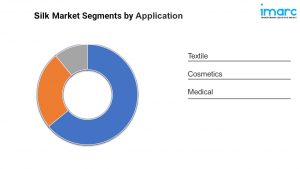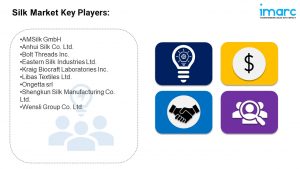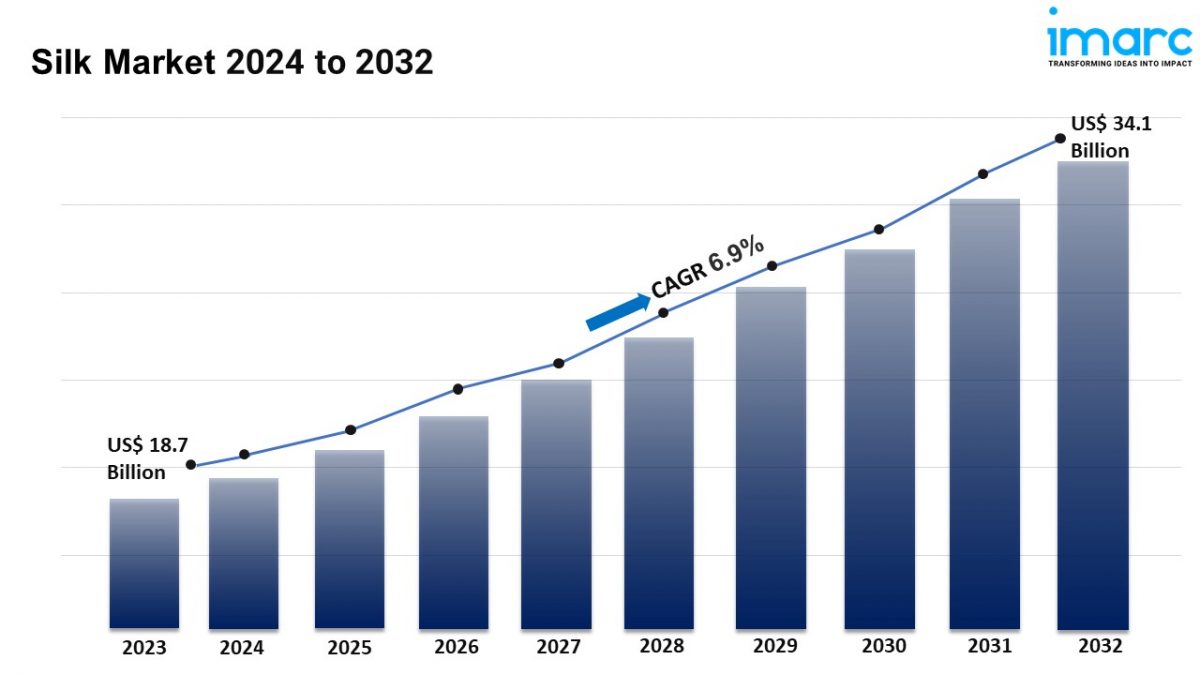Summary:
- The global silk market size reached USD 18.7 Billion in 2023.
- The market is expected to reach USD 34.1 Billion by 2032, exhibiting a growth rate (CAGR) of 6.9% during 2024-2032.
- Asia Pacific leads the market, accounting for the largest Silk market share.
- Mulberry silk accounts for the majority of the market share in the type segment due to its superior quality, wide cultivation, and high demand in luxury textiles.
- Textiles hold the largest share in the silk industry.
- The increasing demand for luxury and high-quality fabrics and expanding application in personal care and healthcare industry are primary drivers of the Silk market.
- Advancements in silk production and breeding techniques that enhance the strength and consistency of silk fibers are reshaping the silk market.
Industry Trends and Drivers:
- Increased Demand for Luxury and High-Quality Fabrics
Silk has long been associated with luxury due to its smooth texture, natural sheen, and breathable quality. Additionally, in the fashion and home textile sectors, there is a growing preference for high-end fabrics, with silk standing out as a symbol of refinement. This shift is particularly noticeable in emerging economies, where rising disposable incomes are driving demand for premium products. Moreover, consumers in these markets are increasingly drawn to materials that offer comfort and style, and silk fits the bill for both. Besides, designers and brands are also leveraging silk’s appeal to create upscale clothing, accessories, and home décor items, further propelling the market growth. As consumers in these regions become more brand-conscious, they tend to gravitate toward fabrics like silk, which convey a sense of status and sophistication, thereby contributing to a steady increase in its popularity.
- Expanding Applications in Healthcare and Personal Care
Silk’s natural hypoallergenic and antimicrobial properties have expanded its use in healthcare and personal care products. Additionally, in the beauty industry, silk pillowcases, sleep masks, and hair accessories are growing in popularity due to their benefits for skin and hair health. Moreover, silk’s smooth texture helps reduce friction, minimizing hair breakage and skin irritation, making it a favorite for those with sensitive skin. Besides this, its moisture-retaining properties make silk products ideal for preventing skin dryness and wrinkles during sleep. Furthermore, the healthcare sector is also recognizing the potential of silk, particularly in wound care and medical devices, where its biocompatibility and non-irritating nature are advantageous. As consumers become more aware regarding these health benefits, the market for silk-based products in personal care and medical applications continues to influence the market growth.
- Technological Advancements
Various innovations in silk production are transforming the industry by improving the quality of silk and making it more cost-effective. Additionally, traditional silk farming has seen advancements in breeding techniques that enhance the strength and consistency of silk fibers. Moreover, modern processing methods have helped reduce production costs, allowing silk to reach a wider market. Besides, a major breakthrough in the industry is lab-grown silk, where silk proteins are synthesized in controlled environments without the need for silkworms. This new method is more sustainable, reducing environmental impact while maintaining the luxurious qualities of natural silk. Furthermore, lab-grown silk also offers the possibility of creating customized silk with specific properties tailored to different applications. These technological strides help make silk more accessible and contribute to its growing market share in various sectors, from fashion to industrial uses across the globe.
Request Sample PDF Report: https://www.imarcgroup.com/silk-market/requestsample
Report Segmentation:
The report has segmented the market into the following categories:
Breakup by Type:
- Mulberry Silk
- Tussar Silk
- Eri Silk
- Others
Mulberry silk dominates the market growth due to its superior quality, wide cultivation, and high demand in luxury textiles.
Breakup by Application:
- Textile
- Cosmetics
- Medical
Textiles hold the largest market share owing to silk’s high demand in fashion, apparel, and home furnishings for its durability and aesthetic appeal.

Market Breakup by Region:
- North America (United States, Canada)
- Asia Pacific (China, Japan, India, South Korea, Australia, Indonesia, Others)
- Europe (Germany, France, United Kingdom, Italy, Spain, Russia, Others)
- Latin America (Brazil, Mexico, Others)
- Middle East and Africa
Asia Pacific holds the leading position owing to a large market for silk driven by major silk-producing countries like China and India, which is dominating global production and exports.
Top Silk Market Leaders:
- AMSilk GmbH
- Anhui Silk Co. Ltd.
- Bolt Threads Inc.
- Eastern Silk Industries Ltd.
- Kraig Biocraft Laboratories Inc.
- Libas Textiles Ltd.
- Ongetta srl
- Shengkun Silk Manufacturing Co. Ltd.
- Wensli Group Co. Ltd.

Note: If you need specific information that is not currently within the scope of the report, we will provide it to you as a part of the customization.
About Us
IMARC Group is a global management consulting firm that helps the world’s most ambitious changemakers to create a lasting impact. The company provide a comprehensive suite of market entry and expansion services. IMARC offerings include thorough market assessment, feasibility studies, company incorporation assistance, factory setup support, regulatory approvals and licensing navigation, branding, marketing and sales strategies, competitive landscape and benchmarking analyses, pricing and cost research, and procurement research.
